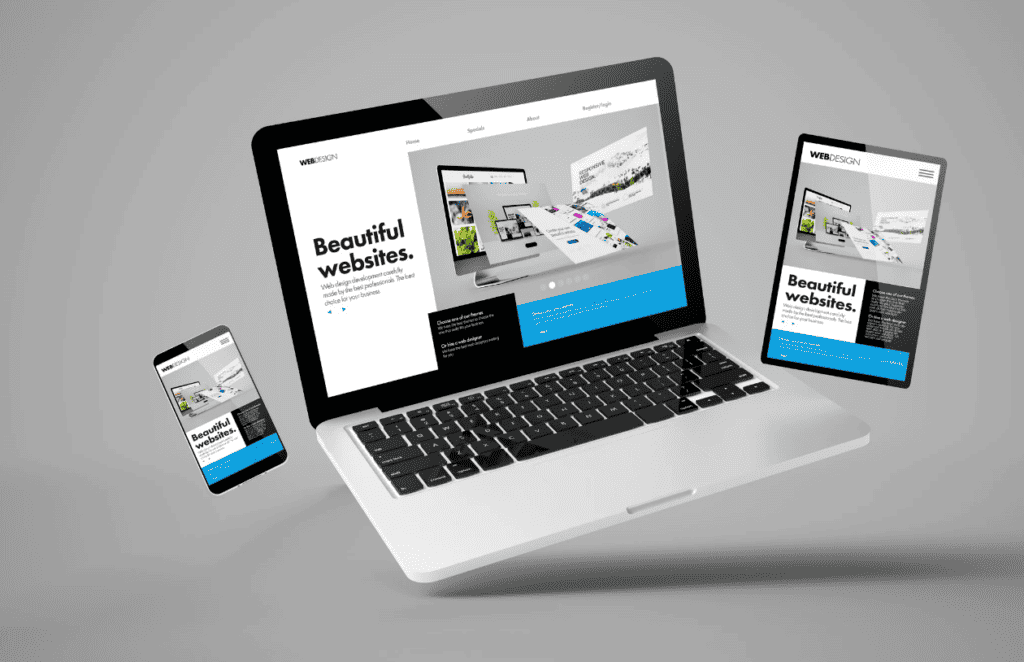In a vast digital landscape that's continually expanding, standing out isn't just about having a presence — it's about being seen and remembered.
Table of Contents
One of the most pivotal yet oft-overlooked drivers of online success is the user experience (UX) that your website fosters. A user who enjoys simplicity finds what they're looking for swiftly, and experiences no hitches in site navigation is a user who's more likely to convert, return, and spread the word.

Crafting a user-friendly website is imperative to keep your audience engaged and your business growing.
Understanding the Essence of User Experience
Effective user experience design is rooted in empathy; it's about understanding your users' needs, behaviors, and motivations. In essence, UX design aims to create websites that are intuitive, functional, and delightful to interact with.

What are the core components of UX design?
- Usability: Is your site easy to use?
- Accessibility: Can all users, regardless of their abilities, navigate your website?
- Credibility: Does your site instill trust in its users?
- Utility: Does your site deliver the content or function for which people visit it?
- Desirability: Does your site appeal to your target audience?
A successful UX conveys the right information at the right time in a format that's easy to digest, while also stirring up a positive emotional response. How can you achieve this on your website? Let's delve deeper.
Asking Professionals for Help
Asking professionals for help can be the key to unlocking the full potential of your website's user experience. Web design services provided by experienced professionals can offer a deep dive analysis of your current UX and pinpoint opportunities for improvement.
These specialists are adept in the latest trends and technologies, ensuring your site is not only aesthetically pleasing but also optimized for user interactions, as the team from Sunlight Media explains.
Furthermore, working with professionals can save you time, as they have the expertise and experience to create a user-friendly website without the trial-and-error approach.
By entrusting your website to those who have honed their skills in creating user-centric platforms, you are investing in a digital space that resonates with your audience and serves your business objectives with precision and creativity.
Establish Clear Navigational Paths
The navigation of your website acts as a roadmap for users. It should guide them to their destination intuitively and efficiently. To craft an effective navigational experience, consider the following guidelines:
- Hierarchy: Organize your content in a clear hierarchy. This helps users understand the relationship between different sections of your site.
- Consistency: Keep navigation elements consistent across your entire website. Once users learn how to navigate one part of your site, they should be able to seamlessly apply that knowledge elsewhere.
- Simplicity: Offer a compact set of options in your primary navigation. Too many choices can overwhelm and confuse visitors.
- Search Functionality: Implement a search bar for users who prefer to look up content directly. This can significantly enhance the user experience, especially for large websites.
By thoughtfully planning and maintaining your website's navigational structure, you set the stage for a user experience that is both logical and intuitive.
Streamline the Registration and Checkout Processes
Streamlining the registration and checkout processes is vital for retaining users and increasing conversions. Simplifying these pathways means removing unnecessary steps and asking for only essential information, which can significantly reduce user frustration and abandonment.
Ensure that forms are easy to fill out and that error messages, if any, provide clear instructions on how to correct the input. Offer multiple payment options to accommodate diverse user preferences, and implement security measures to protect user data and enhance the site's credibility.
By making these processes as effortless as possible, a website can improve overall user satisfaction and foster a seamless user experience.
Optimize for Speed and Performance
A fast-loading website is crucial for user retention. Users tend to have little patience for slow or unresponsive sites.
What can you do to speed up your site's performance?
- Image Optimization: Compress images to reduce file sizes without sacrificing quality.
- Caching: Use browser caching to store resources locally, which minimizes the number of requests for subsequent pages that users view.
- Content Delivery Networks (CDNs): CDNs store copies of your site's assets in data centers around the world, delivering them from the server closest to the user for faster loading times.
- Simplified Code: Minimize and clean up your CSS and JavaScript files to reduce load times.
By keeping your site fast and responsive, you provide a more satisfying user experience that can positively impact your SEO as well.
Embrace Responsive Design
With a growing percentage of website traffic coming from mobile devices, it's essential to ensure your site looks and functions as well on a phone or tablet as it does on a desktop.
How do you achieve this?
- Use a Mobile-First Approach: Design your site with mobile users in mind first, and then scale up for larger screens.
- Responsive Frameworks: Implement a responsive design framework that automatically adjusts layout and content for different screen sizes.
- Prioritize Content: On smaller screens, prioritize the display of the most important content first.
A responsive website is not just about meeting user expectations; it's also a ranking factor in Google's search algorithm.
Conduct User Testing
Conducting user testing is the linchpin of optimizing for an exceptional user experience. Real users bring to light practical insights and behaviors that you might not otherwise anticipate, providing valuable information for improving your website.
By carrying out a variety of tests, such as usability testing, A/B testing, and heat maps, you can observe and analyze how users interact with your site in different scenarios.
This empirical approach enables you to make data-backed decisions, refine user flows, and iron out any kinks that might impede user satisfaction, resulting in a seamless and intuitive user experience.
Remember, even the smallest, incremental changes based on user feedback can lead to significant improvements in the overall user experience of your website. So, embrace user testing as an ongoing process and continuously seek ways to enhance the usability and effectiveness of your site.
Focus on Accessibility
Accessibility ensures that people with disabilities can also use your website. It's both a legal requirement in many jurisdictions and a fundamental aspect of a user-friendly experience.
How can you make your site more accessible?
- Use Alt Text for Images: Screen readers can't interpret images, so provide descriptive alt text for each one.
- Color Contrast: Ensure good color contrast for text to make it readable for people with vision impairments.
- Keyboard Navigation: Make sure all interactive elements are accessible via the keyboard for users who can't use a mouse.
- Descriptive Links: Write clear, descriptive links so users know where they'll be taken when they click.
By incorporating these accessibility best practices, you open your website up to a broader audience and demonstrate a commitment to inclusivity.
Continuously Monitor and Improve
Continuous monitoring and iterative improvement are crucial for maintaining a user-friendly and competitive website. By setting up comprehensive analytics, you can track user behavior, closely monitor key performance indicators (KPIs) to measure engagement, and promptly identify any issues related to site performance.
Additionally, leveraging tools that offer real-time feedback enables you to swiftly address bugs or address user complaints, ensuring a seamless experience. It is also important to stay up-to-date with the latest UX trends and accessibility standards so that your website remains relevant and does not lag behind.
By committing to ongoing enhancement, you not only benefit the end-users but also enhance your brand reputation and improve search engine rankings. Taking these proactive measures will help you stay ahead of the competition and deliver an exceptional online experience.
Leverage Feedback for User Experience Evolution
Listening to your users and incorporating their feedback is not only essential but also crucial for the continuous evolution and enhancement of your website's user experience.
By actively engaging with your audience through various channels such as surveys, feedback forms, and social media interactions, you can gather valuable insights into their preferences, pain points, and expectations.
This allows you to gain a deep understanding of their needs, desires, and challenges, enabling you to make informed adjustments to your website's design, functionality, and content.
Through a process of ongoing improvement and refinement, you can ensure that your website remains user-centered, providing a seamless and delightful experience for your visitors.
By fostering a sense of community and demonstrating your commitment to meeting your users' needs, you not only build trust and loyalty but also create a strong connection with your audience.
This connection becomes the foundation of a thriving digital strategy, enabling you to stay ahead of the curve and deliver exceptional value to your users.

Creating a user-friendly website is a multi-faceted endeavor that demands attention to detail, a deep understanding of your audience, and a commitment to continuous improvement.
By focusing on the essential components of UX design, embracing responsive strategies, conducting thorough user testing, ensuring accessibility, and actively seeking user feedback, you can cultivate an online environment that not only satisfies your users but also surpasses their expectations.
As technology advances and user behaviors change, remember that the pursuit of exceptional UX is never static; it is a dynamic journey that, when navigated thoughtfully, can lead to substantial growth and enduring online success.
FAQs on How To Create a User-Friendly Website
What is the most important aspect of user experience (UX) design?
Usability is often considered the cornerstone of UX design. If users find your website difficult to navigate or understand, it can lead to frustration and website abandonment. A focus on creating intuitive, logical user flows and easy-to-use interfaces is critical for a positive UX.
How do I know if my website is accessible?
To determine if your website is accessible, you should evaluate it against the Web Content Accessibility Guidelines (WCAG). These guidelines provide a framework for making digital content accessible to people with a wide range of disabilities.
Additionally, conducting accessibility audits and involving users with disabilities in user testing can provide practical insights into the accessibility of your site.
Is it necessary to redesign my website for mobile devices?
With mobile internet usage surpassing desktop, having a website optimized for mobile devices is no longer optional—it's essential. A mobile-friendly design ensures that your content is accessible and legible on all devices, providing a consistent user experience and potentially improving your search engine rankings.
How can I collect user feedback effectively?
Collecting user feedback can be achieved through a variety of methods, including surveys, feedback forms, direct user interviews, usability studies, and monitoring social media channels.
It's important to make the feedback process as simple and straightforward as possible to encourage user participation. Implementing tools for collecting real-time feedback on your website can also offer immediate insights into the user experience.


